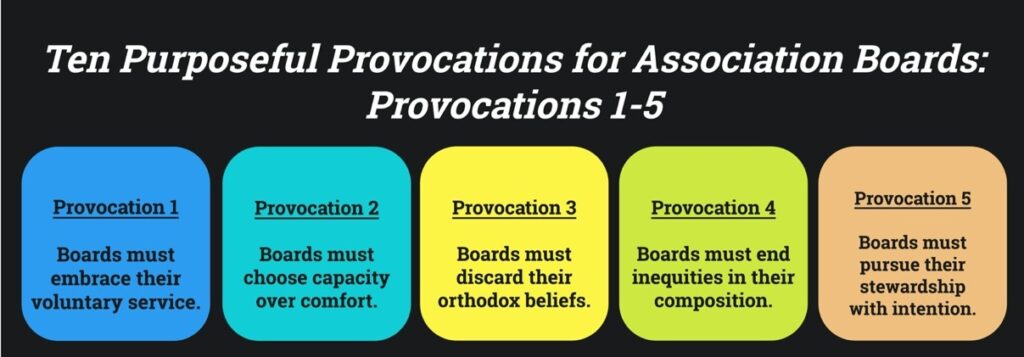Ten Purposeful Provocations for Association Boards: Part I
Last month, in preparation for a presentation, I posted a short article on LinkedIn in which I shared ten purposeful provocations for association boards in 2021. In this two-part series of columns, I want to expand on the original article and include a set of next practices that association boards and chief staff executives can adopt to act on each provocation. This month, I will address five provocations in the visual below.

Provocation 1: Boards must embrace their voluntary service
Association board service is a privilege and a responsibility, not a member benefit. To be clear, serving on the board places directors/officers in unique positions of significant privilege that are entrusted with the awesome responsibility of shaping a different and better future for the association, stakeholders, and successors. It is not for the faint of heart, especially in The Turbulent Twenties.
With this in mind, we must recognize association board service as voluntary, not volunteer. Voluntary service is an unambiguous choice that directors/officers make even before board service begins and it is one they must make freely every day thereafter. For some directors/officers, carrying the burdens of board service may become too difficult, which is understandable. They should not be required to continue bearing them out of either loyalty or obligation. Any director/officer who, for whatever reason, can no longer make an affirmative choice to serve voluntarily should withdraw and allow a successor to replace them.
The clear expectation at the core of this privileged voluntary service is a solemn and binding agreement to perform the work at the highest possible level for the full duration. In an irrevocably-altered world, associations and boards simply cannot settle for anything less.
Provocation 2: Boards must choose capacity over comfort
Since the beginning of the pandemic, association decision-makers have been operating in the radical uncertainty, volatility, and risk of “the discontinuous next.” The global public health crisis was a wild card event that pushed the world off its previous pathway toward the future. It also unleashed a torrent of complex questions and wicked problems requiring immediate actions that are influencing the emergence of the next trajectory. Under extreme stress, association boards and chief staff executives have had to adapt to these unforgiving conditions through learning.
With the pandemic’s second year now underway, this ability to adapt quickly remains critical. The current crisis is far from over, and yet the recent rise in vaccination rates appears to be reducing COVID-19 concerns while deepening the desire to “get back to normal,” as if that is even possible. We will confront numerous threats in The Turbulent Twenties, but right now, the greatest threat facing the association community is the failure to grasp the devastating consequences of a hard turn back toward pre-2020 complacency.
To prevent this renewed complacency from taking hold, boards must accept the inevitable and constructive discomfort of intensifying their pursuit of learning to build new capacity for sustained action to shape a different and better future.
Provocation 3: Boards must discard their orthodox beliefs
Another action association boards and chief staff executives can take to push back against complacency is surfacing, interrogating, and discarding their orthodox beliefs. Orthodox beliefs are the deep-seated assumptions we make about how the world works. (An example of a societal orthodox belief is, “short-term concerns matter more than long-term thinking.”) These mostly invisible ways of thinking have been inculcated into us over many years, and our organizations over many decades. Orthodox beliefs keep associations tethered to the past, prevent necessary learning, and encourage risk avoidance.
In addition to closely examining their own orthodox beliefs, boards must develop a shared understanding of the orthodoxies held by other stakeholders and audiences within the broader industry/professional ecosystems in which their associations operate. These external orthodox beliefs can have an even more significant and detrimental impact on decision-making processes than their associations’ internal belief systems.
To shape a different future for stakeholders and successors, boards must explore a full range of plausible futures through an ongoing cycle of sense-making, meaning-making, and decision-making. As part of their foresight work, association boards must maintain an awareness of the constant presence of orthodox beliefs and challenge them vigorously at every opportunity.
Join the discussion on Clubhouse!
On April 1 at 2 p.m. EDT, I will facilitate a discussion of this column on the popular audio-only social media platform, Clubhouse. (FYI, Clubhouse is iOS only.)
Please join us!
Provocation 4: Boards must end inequities in their composition
At this moment, association boards are not diverse and immediate action to seat directors/officers who bring diversity in all dimensions, including (but not limited to) race, ethnicity, gender/gender identity, sexual orientation, socioeconomic status, and ability status, is essential. Seating diverse boards is a moral imperative in response to the past exclusion of minority candidates from these critical roles. Not only will board diversity strengthen performance today and going forward, it will also help re-establish the legitimacy of association boards as they seek to build mutually-beneficial relationships with and shape more equitable, ethical, humane and just futures for stakeholders and successors.
The effort to create truly diverse boards requires the immediate removal of enduring structural inequities that have prevented associations from identifying, recruiting, and selecting from a broader universe of outstanding board candidates. These barriers, mostly found in governing documents and policy statements, include 1) membership-based eligibility limitations, 2) geographic structures, such as districts or regions, that can constrain inclusion, and 3) electoral-based methods of board composition that favor majority candidates.
Association boards must act decisively to implement equitable board composition requirements and practices to ensure that diverse candidates receive full and fair access to and consideration for board service opportunities.
Provocation 5: Boards must pursue their stewardship with intention
Boards are their association’s primary stewards. To fulfill that role, they must focus their attention on leaving the systems for which they are responsible better than how they found them for the benefit of stakeholders and successors. In The Turbulent Twenties, this responsibility extends beyond associations’ legal boundaries to include the industry/professional ecosystems within which associations operate as well.
While many “leaders” across our society make zero-sum decisions to advance their short-term self-interest, the focus of stewardship is on building the collective capacity to advance our long-term shared interest. At its core, stewardship demands that boards make future-focused choices that unleash our agency to create enduring positive-sum outcomes. Stewardship is a way of being through which diverse contributors co-create stronger systems at every level.
The tendency to default to an increasingly inadequate leadership paradigm has become another form of association orthodoxy. Given the complex challenges we face in this decade and beyond , however, stewardship is a higher calling than leadership. Boards must act on their stewardship with the clear intention to inspire all association stakeholders to make meaningful contributions to that vital work.


